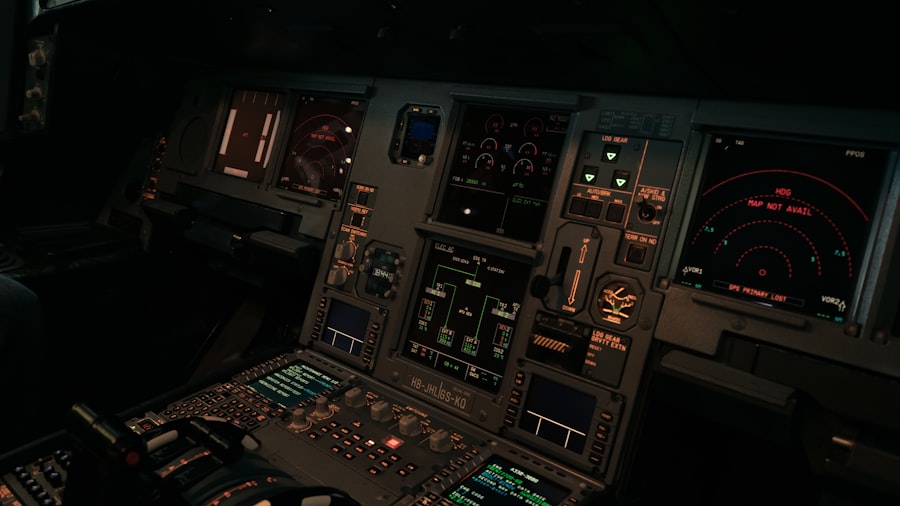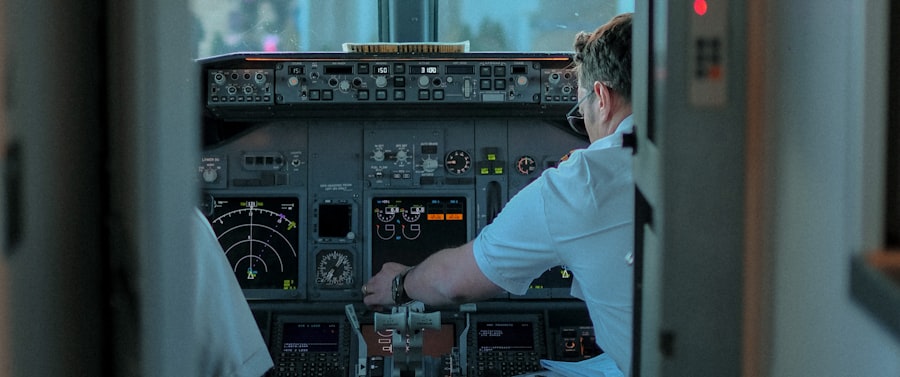As you step into the world of aviation, you may find yourself captivated by the rapid advancements in technology, particularly artificial intelligence (AI). The integration of AI into aviation is not merely a trend; it represents a transformative shift that is reshaping how aircraft are operated, maintained, and navigated. From enhancing flight safety to optimizing fuel efficiency, AI is becoming an indispensable tool in the aviation industry.
As you delve deeper into this subject, you will discover how AI is revolutionizing traditional practices and paving the way for a new era in air travel. The journey of AI in aviation is marked by significant milestones that have gradually built the foundation for its current applications. Initially, AI was primarily used for data analysis and predictive maintenance, but its role has expanded dramatically.
Today, AI systems are capable of performing complex tasks that were once the sole responsibility of human pilots. This evolution raises important questions about the future of aviation and the balance between human expertise and machine efficiency. As you explore these themes, you will gain insight into the profound implications of AI on the aviation landscape.
Key Takeaways
- AI is revolutionizing the aviation industry by introducing advanced technologies to improve safety, efficiency, and decision-making processes.
- While AI is advancing rapidly, the role of pilots in aviation remains crucial for decision-making, problem-solving, and human oversight.
- Advancements in AI technology, such as machine learning and predictive analytics, are enhancing aircraft performance, maintenance, and operational processes.
- The benefits of AI in aviation include improved safety, reduced human error, and increased operational efficiency, but challenges include cybersecurity threats and potential job displacement.
- Safety concerns and regulations are critical factors in the integration of AI in aviation, requiring strict oversight and compliance with industry standards and regulations.
The Role of Pilots in Aviation
Pilots have long been regarded as the backbone of aviation, responsible for ensuring the safety and efficiency of flights. Their training is rigorous, encompassing a wide range of skills from navigation to emergency response. As you consider the multifaceted role of pilots, it becomes clear that their expertise extends beyond simply flying an aircraft; they are also critical decision-makers who must assess situations in real-time.
This human element is what has traditionally set pilots apart from machines, as they bring intuition and experience to the cockpit. However, as AI technology continues to advance, the role of pilots is evolving. While they remain essential for overseeing flight operations, their responsibilities are increasingly complemented by AI systems that assist with navigation, communication, and even decision-making processes.
This shift does not diminish the importance of pilots; rather, it enhances their capabilities by providing them with tools that can analyze vast amounts of data quickly and accurately. As you reflect on this evolution, you may find yourself pondering how pilots will adapt to these changes and what new skills they will need to thrive in an AI-enhanced environment.
Advancements in AI Technology

The advancements in AI technology are nothing short of remarkable, particularly in the context of aviation. Machine learning algorithms and neural networks have made it possible for systems to learn from vast datasets, improving their performance over time. For instance, AI can analyze historical flight data to predict potential mechanical failures before they occur, allowing for proactive maintenance and reducing downtime.
As you explore these technological breakthroughs, you will appreciate how they contribute to safer and more efficient air travel. Moreover, AI is being integrated into various aspects of aviation beyond just maintenance. Autonomous flight systems are being developed that can take off, navigate, and land without human intervention.
While fully autonomous commercial flights may still be on the horizon, the progress made thus far is impressive. You may find it fascinating to consider how these advancements could change the dynamics of air travel, making it more accessible and cost-effective while also raising questions about the future role of human pilots.
Benefits and Challenges of AI in Aviation
| Benefits of AI in Aviation | Challenges of AI in Aviation |
|---|---|
| Improved safety through predictive maintenance | Concerns about job displacement |
| Enhanced operational efficiency | Regulatory and ethical considerations |
| Advanced flight planning and route optimization | Reliability and trust in AI systems |
| Enhanced passenger experience through personalized services | Data privacy and security concerns |
The benefits of incorporating AI into aviation are numerous and far-reaching. One of the most significant advantages is enhanced safety. AI systems can process information at speeds far beyond human capabilities, allowing for quicker responses to potential hazards.
Additionally, AI can assist in optimizing flight paths, reducing fuel consumption, and minimizing delays.
However, with these benefits come challenges that must be addressed.
One major concern is the reliance on technology and the potential for system failures. While AI can significantly reduce human error, it is not infallible. You may find yourself considering scenarios where technical malfunctions could lead to catastrophic outcomes if not properly managed.
Furthermore, there are ethical considerations surrounding decision-making in critical situations where human lives are at stake. Balancing the advantages of AI with these challenges will be crucial as the aviation industry continues to evolve.
Safety Concerns and Regulations
Safety is paramount in aviation, and as AI becomes more integrated into flight operations, regulatory frameworks must adapt accordingly. You may wonder how existing regulations will evolve to accommodate AI technologies while ensuring passenger safety remains uncompromised. Regulatory bodies like the Federal Aviation Administration (FAA) are already exploring guidelines for autonomous systems and AI-assisted operations.
This ongoing dialogue between technology developers and regulators is essential for establishing standards that prioritize safety without stifling innovation. Moreover, public trust in AI systems is a critical factor that cannot be overlooked. As you consider the implications of AI in aviation, you might reflect on how safety concerns can influence public perception and acceptance of new technologies.
Transparency in how AI systems operate and how safety measures are implemented will be vital in fostering confidence among passengers and stakeholders alike.
The Potential Impact on the Job Market

The rise of AI in aviation inevitably raises questions about its impact on employment within the industry. As automation becomes more prevalent, you may find yourself contemplating how this shift will affect pilots and other aviation professionals. While some roles may become obsolete due to increased automation, new opportunities will also emerge as technology evolves.
For instance, there will be a growing demand for specialists who can develop, maintain, and oversee AI systems. Additionally, as pilots transition into roles that require more oversight and management of automated systems, they will need to acquire new skills to remain competitive in the job market. You might consider how pilot training programs will adapt to incorporate these changes and prepare future aviators for a landscape where human-machine collaboration is the norm.
The Role of Human Oversight in AI-Piloted Aircraft
Even as AI technology advances, the importance of human oversight cannot be overstated. You may find it reassuring to know that while AI can enhance flight operations, human pilots will still play a crucial role in monitoring systems and making critical decisions when necessary. The concept of “human-in-the-loop” systems emphasizes that while machines can assist with routine tasks, human judgment remains essential during complex or unforeseen situations.
This partnership between humans and machines creates a dynamic where pilots can leverage AI’s capabilities while retaining ultimate responsibility for flight safety. As you explore this relationship further, you might reflect on how effective communication between pilots and AI systems will be vital for ensuring smooth operations and maintaining safety standards.
The Future of Pilot Training and Education
As AI continues to reshape aviation, pilot training programs will need to evolve accordingly. You may envision a future where aspiring pilots are trained not only in traditional flying skills but also in understanding and managing advanced technologies like AI systems. This shift will require educational institutions to develop curricula that emphasize both technical proficiency and critical thinking skills.
Moreover, simulation training will likely become more sophisticated as AI technologies advance. You might imagine immersive training environments where pilots can practice interacting with AI systems in real-time scenarios, preparing them for the complexities of modern aviation operations. This evolution in training will ensure that future pilots are well-equipped to navigate an increasingly automated landscape.
The Economic Implications of AI in Aviation
The economic implications of integrating AI into aviation are profound and multifaceted. On one hand, increased efficiency through automation can lead to significant cost savings for airlines and operators.
As you consider these economic benefits, it becomes clear that airlines could pass on some savings to consumers through lower ticket prices. On the other hand, there are concerns about job displacement as automation becomes more prevalent. You may find yourself pondering how this shift will affect not only pilots but also ground staff and other aviation professionals whose roles may be impacted by technological advancements.
Balancing economic growth with workforce stability will be a critical challenge for industry leaders as they navigate this transition.
Public Perception and Acceptance of AI-Piloted Aircraft
Public perception plays a pivotal role in determining the success of AI-piloted aircraft. As you think about how passengers might react to flying on an aircraft operated primarily by AI systems, you may recognize that trust is a significant factor. Many individuals may feel apprehensive about relinquishing control to machines, especially when it comes to their safety during air travel.
To foster acceptance, transparency about how AI systems work and their safety measures will be essential. You might consider how airlines can engage with passengers through educational campaigns that demystify AI technology and highlight its benefits. Building public confidence will be crucial for ensuring a smooth transition toward more automated flight operations.
The Outlook for AI in Aviation
As you reflect on the integration of AI into aviation, it becomes evident that this technology holds immense potential for transforming the industry. From enhancing safety to improving operational efficiency, the benefits are substantial. However, navigating the challenges associated with this transition will require careful consideration of regulatory frameworks, workforce implications, and public perception.
The future of aviation is likely to be characterized by a harmonious partnership between humans and machines, where pilots leverage advanced technologies while maintaining oversight and decision-making authority. As you look ahead, it’s clear that embracing innovation while prioritizing safety and public trust will be key to unlocking the full potential of AI in aviation. The journey has just begun, but the possibilities are limitless as we soar into this new era together.
The debate over whether AI can take over pilot jobs is gaining traction as technology continues to advance at a rapid pace. While some argue that AI could enhance safety and efficiency in aviation, others raise concerns about the loss of human judgment and experience in critical situations. An interesting perspective on the broader implications of AI in various industries can be found in an article on How Wealth Grows, which discusses the potential economic impacts of AI and automation. For more insights, you can read the full article here.
FAQs
What is AI?
AI, or artificial intelligence, refers to the simulation of human intelligence in machines that are programmed to think and act like humans. This includes tasks such as learning, problem-solving, and decision-making.
Can AI take over pilot jobs?
While AI technology has advanced significantly, it is not currently capable of completely taking over pilot jobs. Pilots require a combination of technical skills, decision-making abilities, and situational awareness that AI is not yet able to replicate.
How is AI used in aviation?
AI is currently used in aviation for tasks such as autopilot systems, predictive maintenance, and air traffic control. These applications assist pilots and air traffic controllers but do not replace the need for human intervention.
What are the limitations of AI in aviation?
AI in aviation still has limitations in terms of handling unexpected situations, adapting to rapidly changing conditions, and making complex decisions based on human judgment and intuition. These are areas where human pilots excel.
Will AI completely replace pilots in the future?
While AI technology continues to advance, it is unlikely that AI will completely replace pilots in the near future. The role of pilots involves a level of human judgment, communication, and adaptability that AI has not yet achieved.
